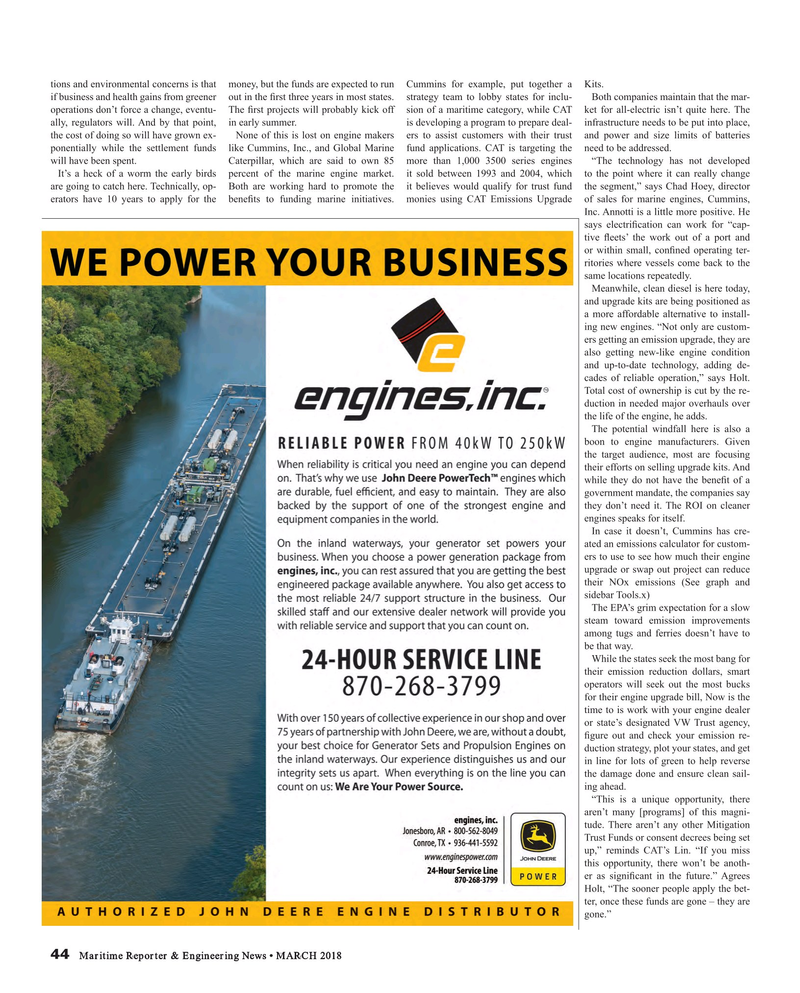
Page 44: of Maritime Reporter Magazine (March 2018)
Annual World Yearbook
Read this page in Pdf, Flash or Html5 edition of March 2018 Maritime Reporter Magazine
tions and environmental concerns is that money, but the funds are expected to run Cummins for example, put together a Kits. if business and health gains from greener out in the ? rst three years in most states. strategy team to lobby states for inclu- Both companies maintain that the mar- operations don’t force a change, eventu- The ? rst projects will probably kick off sion of a maritime category, while CAT ket for all-electric isn’t quite here. The ally, regulators will. And by that point, in early summer. is developing a program to prepare deal- infrastructure needs to be put into place, the cost of doing so will have grown ex- None of this is lost on engine makers ers to assist customers with their trust and power and size limits of batteries ponentially while the settlement funds like Cummins, Inc., and Global Marine fund applications. CAT is targeting the need to be addressed. will have been spent. Caterpillar, which are said to own 85 more than 1,000 3500 series engines “The technology has not developed
It’s a heck of a worm the early birds percent of the marine engine market. it sold between 1993 and 2004, which to the point where it can really change are going to catch here. Technically, op- Both are working hard to promote the it believes would qualify for trust fund the segment,” says Chad Hoey, director erators have 10 years to apply for the bene? ts to funding marine initiatives. monies using CAT Emissions Upgrade of sales for marine engines, Cummins,
Inc. Annotti is a little more positive. He says electri? cation can work for “cap- tive ? eets’ the work out of a port and or within small, con? ned operating ter- ritories where vessels come back to the same locations repeatedly.
Meanwhile, clean diesel is here today, and upgrade kits are being positioned as a more affordable alternative to install- ing new engines. “Not only are custom- ers getting an emission upgrade, they are also getting new-like engine condition and up-to-date technology, adding de- cades of reliable operation,” says Holt.
Total cost of ownership is cut by the re- duction in needed major overhauls over the life of the engine, he adds.
The potential windfall here is also a boon to engine manufacturers. Given the target audience, most are focusing their efforts on selling upgrade kits. And while they do not have the bene? t of a government mandate, the companies say they don’t need it. The ROI on cleaner engines speaks for itself.
In case it doesn’t, Cummins has cre- ated an emissions calculator for custom- ers to use to see how much their engine upgrade or swap out project can reduce their NOx emissions (See graph and sidebar Tools.x)
The EPA’s grim expectation for a slow steam toward emission improvements among tugs and ferries doesn’t have to be that way.
While the states seek the most bang for their emission reduction dollars, smart operators will seek out the most bucks for their engine upgrade bill, Now is the time to is work with your engine dealer or state’s designated VW Trust agency, ? gure out and check your emission re- duction strategy, plot your states, and get in line for lots of green to help reverse the damage done and ensure clean sail- ing ahead. “This is a unique opportunity, there aren’t many [programs] of this magni- tude. There aren’t any other Mitigation
Trust Funds or consent decrees being set up,” reminds CAT’s Lin. “If you miss this opportunity, there won’t be anoth- er as signi? cant in the future.” Agrees
Holt, “The sooner people apply the bet- ter, once these funds are gone – they are gone.” 44 Maritime Reporter & Engineering News • MARCH 2018
MR #3 (42-49).indd 44 MR #3 (42-49).indd 44 3/8/2018 4:01:15 PM3/8/2018 4:01:15 PM

 43
43

 45
45
